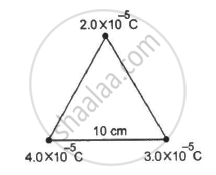Advertisements
Advertisements
प्रश्न
Find the speed of the electron in the ground state of a hydrogen atom. The description of ground state is given in the previous problem.
उत्तर
Given:
Separation between the two charges, r = 0.53 Å = 0.53 × 10−10 m
By Coulomb's Law, force,
\[F = \frac{1}{4\pi \epsilon_0}\frac{q_1 q_2}{r^2}\]
Here,
\[\Rightarrow F = \frac{9 \times {10}^9 \times \left( 1 . 6 \times {10}^{- 19} \right)^2}{\left( 0 . 53 \times {10}^{- 10} \right)^2}\]
\[ = 8 . 2 \times {10}^{- 8} N\]
Now, mass of an electron, Me = 9.12 × 10−31 kg
The necessary centripetal force is provided by the Coulombian force.
\[\Rightarrow F_e = \frac{M_e v^2}{r}\]
\[ \Rightarrow v^2 = 0 . 4775 \times {10}^{13} \]
\[ = 4 . 775 \times {10}^{12} \]
\[ \Rightarrow v = 2 . 18 \times {10}^6 \] m/s
APPEARS IN
संबंधित प्रश्न
Two equal balls with equal positive charge 'q' coulombs are suspended by two insulating strings of equal length. What would be the effect on the force when a plastic sheet is inserted between the two?
The electrostatic force on a small sphere of charge 0.4 μC due to another small sphere of charge − 0.8 μC in air is 0.2 N.
- What is the distance between the two spheres?
- What is the force on the second sphere due to the first?
Four point charges qA = 2 μC, qB = −5 μC, qC = 2 μC, and qD = −5 μC are located at the corners of a square ABCD of side 10 cm. What is the force on a charge of 1 μC placed at the centre of the square?
- Two insulated charged copper spheres A and B have their centers separated by a distance of 50 cm. What is the mutual force of electrostatic repulsion if the charge on each is 6.5 × 10−7 C? The radii of A and B are negligible compared to the distance of separation.
- What is the force of repulsion if each sphere is charged double the above amount, and the distance between them is halved?
Find the electric force between two protons separated by a distance of 1 fermi (1 fermi = 10−15 m). The protons in a nucleus remain at a separation of this order.
Estimate the number of electrons in 100 g of water. How much is the total negative charge on these electrons?
Suppose an attractive nuclear force acts between two protons which may be written as F=Ce−kr/r2. Suppose that k = 1 fermi−1 and that the repulsive electric force between the protons is just balanced by the attractive nuclear force when the separation is 5 fermi. Find the value of C.
A hydrogen atom contains one proton and one electron. It may be assumed that the electron revolves in a circle of radius 0.53 angstrom (1 angstrom = 10−10 m and is abbreviated as Å ) with the proton at the centre. The hydrogen atom is said to be in the ground state in this case. Find the magnitude of the electric force between the proton and the electron of a hydrogen atom in its ground state.
Two identical pith balls are charged by rubbing one against the other. They are suspended from a horizontal rod through two strings of length 20 cm each, the separation between the suspension points being 5 cm. In equilibrium, the separation between the balls is 3 cm. Find the mass of each ball and the tension in the strings. The charge on each ball has a magnitude 2.0 × 10−8 C.
How much work has to be done in assembling three charged particles at the vertices of an equilateral triangle, as shown in the figure?
Answer the following question.
What is relative permittivity?
What are the differences between the Coulomb force and the gravitational force?
Two-point charges of + 0.2 µµC and -0.2 µµC are separated by 1 o8 m. What is the value of the electric field at an axial point at a distance of 0.1 m from their mid-point?
Two positive charges ______.
Two identical thin rings, each of radius a meter, are coaxially placed at a distance R meter apart. If Q1 coulomb and Q2 coulomb are respectively the charges uniformly spread on the two rings, the work done in moving a charge q coulomb from the centre of one ring to that of the other is ______.
SI unit of permittivity of free space is ______.
Coulomb's law is given by F = k q1q2 rn where n is
According to Coulomb's law, which is the correct relation for the following figure?

